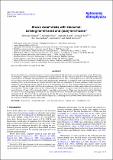Files in this item
Brown dwarf disks with Herschel: linking far-infrared and (sub)-mm fluxes
Item metadata
| dc.contributor.author | Daemgen, Sebastian | |
| dc.contributor.author | Natta, Antonella | |
| dc.contributor.author | Scholz, Alexander | |
| dc.contributor.author | Testi, Leonardo | |
| dc.contributor.author | Jayawardhana, Ray | |
| dc.contributor.author | Greaves, Jane | |
| dc.contributor.author | Eastwood, Daniel | |
| dc.date.accessioned | 2016-11-08T12:30:11Z | |
| dc.date.available | 2016-11-08T12:30:11Z | |
| dc.date.issued | 2016-10-14 | |
| dc.identifier | 247491426 | |
| dc.identifier | dbe796f2-2f16-45af-bc0d-24c533238334 | |
| dc.identifier | 84992051126 | |
| dc.identifier | 000385832200067 | |
| dc.identifier.citation | Daemgen , S , Natta , A , Scholz , A , Testi , L , Jayawardhana , R , Greaves , J & Eastwood , D 2016 , ' Brown dwarf disks with Herschel : linking far-infrared and (sub)-mm fluxes ' , Astronomy & Astrophysics , vol. 594 , A83 . https://doi.org/10.1051/0004-6361/201628431 | en |
| dc.identifier.issn | 0004-6361 | |
| dc.identifier.other | RIS: 10.105100046361201628431 | |
| dc.identifier.uri | https://hdl.handle.net/10023/9786 | |
| dc.description | AN would like to acknowledge funding from Science Foundation Ireland (Grant 13/ERC/I2907). AS acknowledges support from STFC grant ST/M001296/1. This work was partly supported by the Italian Ministero dell’Istruzione, Università e Ricerca through the grant Progetti Premiali 2012 – iALMA (CUP C52I13000140001). Our research was also supported by NSERC grants to RJ. | en |
| dc.description.abstract | Brown dwarf disks are excellent laboratories to test our understanding of disk physics in an extreme parameter regime. In this paper we investigate a sample of 29 well-characterized brown dwarfs and very low-mass stars, for which Herschel far-infrared fluxes and (sub)-mm fluxes are available. We measured new Herschel/PACS fluxes for 11 objects and complement these with (sub)-mm data and Herschel fluxes from the literature. We analyze their spectral energy distributions in comparison with results from radiative transfer modeling. Fluxes in the far-infrared are strongly affected by the shape and temperature of the disk (and hence stellar luminosity), whereas the (sub)-mm fluxes mostly depend on disk mass. Nevertheless, there is a clear correlation between far-infrared and (sub)-mm fluxes. We argue that the link results from the combination of the stellar mass-luminosity relation and a scaling between disk mass and stellar mass. We find strong evidence of dust settling to the disk midplane. The spectral slopes between near- and far-infrared are mostly between −0.5 and −1.2 in our sample, which is comparable to more massive T Tauri stars; this may imply that the disk shapes are similar as well, although highly flared disks are rare among brown dwarfs. We find that dust temperatures in the range of 7−15 K, calculated with T ≈ 25 (L/L⊙)0.25 K, are appropriate for deriving disk masses from (sub)-mm fluxes for these low luminosity objects. About half of our sample hosts disks with at least one Jupiter mass, confirming that many brown dwarfs harbor sufficient material for the formation of Earth-mass planets in their midst. | |
| dc.format.extent | 16 | |
| dc.format.extent | 1632909 | |
| dc.language.iso | eng | |
| dc.relation.ispartof | Astronomy & Astrophysics | en |
| dc.subject | Stars: brown dwarfs | en |
| dc.subject | Circumstellar matter | en |
| dc.subject | Stars: pre-main sequence | en |
| dc.subject | Infrared: stars | en |
| dc.subject | Submillimeter: stars | en |
| dc.subject | QB Astronomy | en |
| dc.subject | QC Physics | en |
| dc.subject | 3rd-DAS | en |
| dc.subject.lcc | QB | en |
| dc.subject.lcc | QC | en |
| dc.title | Brown dwarf disks with Herschel: linking far-infrared and (sub)-mm fluxes | en |
| dc.type | Journal article | en |
| dc.contributor.sponsor | Science & Technology Facilities Council | en |
| dc.contributor.institution | University of St Andrews. School of Physics and Astronomy | en |
| dc.identifier.doi | 10.1051/0004-6361/201628431 | |
| dc.description.status | Peer reviewed | en |
| dc.identifier.url | https://arxiv.org/abs/1607.07458 | en |
| dc.identifier.grantnumber | ST/M001296/1 | en |
This item appears in the following Collection(s)
Items in the St Andrews Research Repository are protected by copyright, with all rights reserved, unless otherwise indicated.

